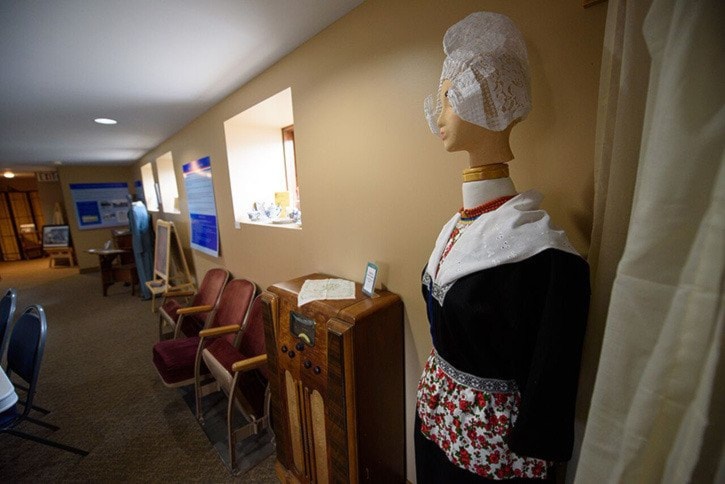BY RYAN WELLICOME
Lacombe Express
The Lacombe & District Historical Society unveiled two brand new exhibits at the Flatiron Museum at an open event last week.
The exhibits, called ‘Catalysts for Change: Local Women & the Suffrage Movement’ and ‘The Origins of Lacombe’s Dutch Community’ showcase Lacombe’s women who helped bring about social and political change and the history of Lacombe’s prominent Dutch community.
The Catalysts for Change exhibit explores the contributions of local women to the women’s suffrage movement of the early 20th century and comes with the 100th anniversary of women landing the right to vote in Alberta.
“We decided to create an exhibit that would highlight the theme but also raise awareness of some of the amazing women that lived, specifically, here in our area,” said Marie Péron, executive director of the Lacombe & District Historical Society and Lacombe Regional Tourism. “ I think it is important because it illustrates how far women’s rights, and human rights in general, have come in a span of 100 years,” she said.
“It reminds people of the debates that people used to have around rights and makes people reflect on some of the conversations that are going on currently.”
The exhibit features an antique patchwork quilt dated, “As early as 1915,” many old photographs from the historical society’s archive as well as snippets from articles published in the Western Globe including a column written by Nellie McClung, one of Canada’s Famous Five.
“To have some needle craftwork in pristine condition from that time period is remarkable and it helps us really tell the story of some of these early women’s groups and how they came to be,” said Péron. “The stories and the artifacts are quite special.
“One of the really interesting things is also our local connection to the greater narrative of women’s rights and looking at how the suffrage movement wasn’t exclusive to Edmonton, Calgary and other urban centres but was also in smaller, rural communities,” she said. “There was a strong influence from the suffrage movement to our community.”
The exhibit tells the story of Irene Parlby who was elected to the Alberta Legislature for the riding of Lacombe in 1921 (a post she held for 14 years) and was Alberta’s first female cabinet minister and the second woman in Canada to hold a provincial cabinet post.
Parlby, also a member of Canada’s Famous Five, was instrumental in petitioning Canada’s Supreme Court; a petition that eventually led to the Living Tree Doctrine.
“In the end, (she) had such a strong influence on a matter that touched women all across the commonwealth,” said Péron.
Parlby was a resident of Alix.
Manitoba was the first province to grant women the right to vote and hold provincial office on Jan. 28th, 1916.
Saskatchewan and Alberta soon followed on March 14th and April 19th of the same year, respectively.
The ‘Origins of Lacombe’s Dutch Community’ exhibit is intended to remind Lacombe of its deep Dutch roots.
“I think that is an important exhibit for people to learn about how the Dutch community in our area came to be and to celebrate their culture,” said Péron. “It’s a wonderful way for us to highlight Canadian and Dutch friendship in the context of immigration and settlement to our country,” she said.
“It is such a big part of our community and it speaks to what their role was and its development.”
Dutch is a widely spoken language in Lacombe and the area and its roots within the community go back to the early 20th century.
“I think its importance has to do with just remembering where you came from, and that’s for everybody,” said Lacombe resident Wilma Busaan. “It doesn’t matter what nationality or ethnic group you belong to, I think it’s always important to know where you came from.”
Busaan’s grandparents emigrated, with Busaan’s mother (six at the time), to Shackleton, Saskatchewan from the Netherlands in 1928.
During the Great Depression of the 1930s, Saskatchewan, as with most of the Great Plains throughout North America, experienced a long, significant drought.
The drought conditions, coupled with high winds created what was known as ‘The Dust Bowl.’
Land in much of the Great Plains became arid and infertile leading Busaan’s family to settle in Lacombe in 1937.
<p style="margin-top: 0px; margin-bottom: 0.5em; color: #000000; font-family: Georgia, Times, serif, 'Lucida Grande', Tahoma, Arial, Verdana, sans-serif; font-size: 16px; font-style: normal; font-variant: normal; font-weight: normal; letter-spacing: normal; line-height: normal; orphans: auto; text-align: start; text-indent: 0px; text-transform: none; white-space: normal
